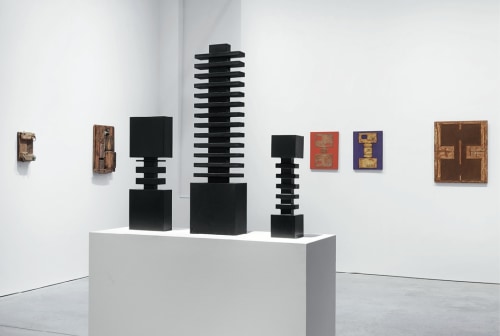
Installation view of Elsa Gramcko: The Invisible Plot of Things, James Cohan, New York. Photo courtesy Artforum.
Elsa Gramcko
JAMES COHAN | 48 WALKER ST
In 1956, Elsa Gramcko (1925–1994) was invited to participate in a group exhibition at the Museum of Fine Arts, Houston (MFAH). The show’s curator, José Gómez-Sicre, was so taken with the young Venezuelan’s paintings that he organized her first solo presentation at the Pan American Union in Washington, DC, three years later. This was swiftly followed by multiple solo outings at the Museo de Bellas Artes de Caracas, inclusion in the 1964 Venice Biennale, and receipt of Venezuela’s National Art Prize in Sculpture in 1968. However, Gramcko retreated from the art world in the late 1970s, thus becoming a little-known figure outside of her own country. Yet when the artist’s creations resurfaced in MFAH’s 2018–19 survey “Contesting Modernity: Informalism in Venezuela, 1955–1975,” they again struck a chord: Gabriela Rangel, who contributed to the show’s catalogue, was moved to curate this concise retrospective of Gramcko’s work.
“The Invisible Plot of Things,” which traveled from Houston’s Sicardi|Ayers|Bacino gallery to James Cohan, featured canvases, wall-mounted assemblages, and a trio of freestanding iron sculptures, all made between 1954 and 1977. The show underscored Gramcko’s remarkable material and stylistic breadth, a testament to her restless need for experimentation and evolution. (To wit: Curator Juan Carlos López Quintero, who organized Gramcko’s first retrospective at the Galería de Arte Nacional Caracas in 1997, placed the artist’s twenty-six-year output in fifteen distinct categories.) Gramcko began making art in Caracas against a backdrop of ample crude-oil production and rapid infrastructural development. Venezuela’s modernization project became the perfect setting for public sculpture commissions in a geometrically abstract style, such as those by Alejandro Otero, Gramcko’s mentor at the Escuela de Artes Plásticas y Aplicadas de Caracas. Prior to her turn toward informalism (an aesthetic relatively ill-suited to national pageantry), Gramcko anticipated, in her early abstract painting, the mechanical detritus of her later assemblages. Take Untitled, a riot of what appear to be piston pumps rendered on an oleaginous ground, evoking, in the context of the osseous structures in a neighboring canvas, No. 6 (both 1957), our own internal hydraulics.
R-33, Todo comienza aquí (R-33, It All Begins Here), 1960, a painting of a red oval in a black field, heralded a shift. Flying in the face of pictorial logic, the ensuing pictures were material-driven; their encrusted surfaces, built up from dark acrylic paint mixed with sand, lacerated and cratered. Around 1962, Gramcko began to incorporate castoffs from what she termed “the world of things” into her informalist work. El castillo de Elsinor (Elsinore’s Castle), 1963, has a scabrous surface embedded with corroded car-battery cells—precarious umber stacks that conjured Caracas’s neglected barrios. Clustered on a red wall, seven square works from 1965 and 1966 featured thick, craggy expanses made with cement. At the center of each one was a circular piece of junk, typically a scavenged auto part—a headlight, a clutch, a gear—resembling a single glaring eye. Normally, this type of machinery, which invisibly greased the wheels of the petrostate, would have gone unnoticed. Yet Gramcko’s interventions made the parts perceptible as things, laid bare as an unruly concatenation of the concrete, the social, and the erotic.
El arquetipo del héroe (The Hero’s Archetype), 1975, is a wall relief made from sheet metal cut to resemble a totemic capital I that’s been set into wood marked with asemic scrawls. The work felt like an ancient cave engraving pulled from a contemporary junkyard, an object charged by both past and present whose title nods to Carl Jung’s theory of a collective—timeless, placeless—unconscious. For Gramcko, Jungian individuation seemed like a way to protect oneself from the cold mechanization of modern life; in 1976, the artist said she made art “to defend us against becoming automated machines . . . teeth on a gear.” Evincing a craftier sense of facture, the mature series “Bocetos para un artesano de nuestro tiempo” (Sketches by an Artisan of Our Time), 1974–78, comprises assemblages fashioned from salvaged wood and construction debris. Wanting to communicate more directly with her audience, Gramcko wrote words such as TECHNOLOGY, ALIENATION, and LOVE—which, too, are things—on these pieces. But perhaps this action was superfluous, because her searching, sensitive work never required written language to reach people; her art was imbued with a bracing human spirit that eschewed alienation at every turn.
— Cassie Packard